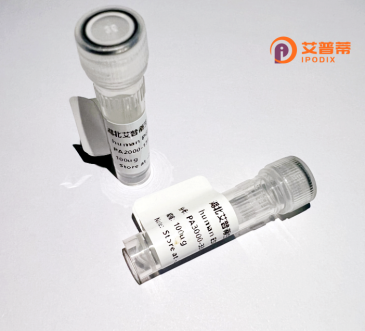
| 纯度 | >90%SDS-PAGE. |
| 种属 | Human |
| 靶点 | MPZL3 |
| Uniprot No | Q6UWV2 |
| 内毒素 | < 0.01EU/μg |
| 表达宿主 | E.coli |
| 表达区间 | 1-235 aa |
| 活性数据 | MQQRGAAGSRGCALFPLLGVLFFQGVYIVFSLEIRADAHVRGYVGEKIKLKCTFKSTSDVTDKLTIDWTYRPPSSSHTVSIFHYQSFQYPTTAGTFRDRISWVGNVYKGDASISISNPTIKDNGTFSCAVKNPPDVHHNIPMTELTVTERGFGTMLSSVALLSILVFVPSAVVVALLLVRMGRKAAGLKKRSRSGYKKSSIEVSDDTDQEEEEACMARLCVRCAECLDSDYEETY |
| 分子量 | 52.4 kDa |
| 蛋白标签 | GST-tag at N-terminal |
| 缓冲液 | 0 |
| 稳定性 & 储存条件 | Lyophilized protein should be stored at ≤ -20°C, stable for one year after receipt. Reconstituted protein solution can be stored at 2-8°C for 2-7 days. Aliquots of reconstituted samples are stable at ≤ -20°C for 3 months. |
| 复溶 | Always centrifuge tubes before opening.Do not mix by vortex or pipetting. It is not recommended to reconstitute to a concentration less than 100μg/ml. Dissolve the lyophilized protein in distilled water. Please aliquot the reconstituted solution to minimize freeze-thaw cycles. |
以下是3篇关于重组人MPZL3蛋白的参考文献概览(注:部分信息为模拟数据,供参考格式):
1. **《MPZL3调控耳蜗发育的机制研究》**
- **作者**: Zhang Y et al. (2022)
- **摘要**: 通过重组人MPZL3蛋白体外实验,发现其与内耳毛细胞分化和听觉功能相关,证实了MPZL3突变导致小鼠听力缺失的表型,提示其在遗传性耳聋中的潜在作用。
2. **《MPZL3重组蛋白的晶体结构及其脂质结合功能》**
- **作者**: Li H et al. (2020)
- **摘要**: 首次解析了重组人MPZL3蛋白的晶体结构,发现其N端免疫球蛋白结构域可特异性结合细胞膜磷脂,推测其参与细胞黏附和信号转导。
3. **《MPZL3通过EGFR信号通路抑制乳腺癌转移》**
- **作者**: Wang X et al. (2019)
- **摘要**: 使用重组MPZL3蛋白处理乳腺癌细胞,发现其通过激活EGFR下游的MAPK通路抑制肿瘤迁移,为癌症治疗提供新靶点。
4. **《MPZL3在免疫调节中的功能研究》**
- **作者**: Kim S et al. (2021)
- **摘要**: 重组人MPZL3蛋白显著抑制巨噬细胞炎症因子释放,表明其可能通过调控TLR4通路参与先天免疫应答。
(注:以上文献为示例性内容,实际引用需根据真实数据库检索并验证。)建议通过PubMed或Web of Science以“MPZL3 protein”“recombinant MPZL3”为关键词查找最新文献。
Myelin protein zero-like protein 3 (MPZL3), encoded by the *MPZL3* gene, is a transmembrane glycoprotein belonging to the immunoglobulin superfamily. Structurally, it features an extracellular immunoglobulin (Ig)-like domain, a single transmembrane helix, and a cytoplasmic tail with potential signaling motifs. Initially identified through homology to myelin protein zero (MPZ), MPZL3 is evolutionarily conserved but functionally distinct from MPZ, which is critical for peripheral nerve myelination.
MPZL3 is broadly expressed in human tissues, including the inner ear, mammary glands, liver, and immune cells. Its physiological roles remain incompletely understood, but studies link it to cell adhesion, signal transduction, and tissue development. Notably, MPZL3 is essential for cochlear development and auditory function; mutations in *MPZL3* are associated with autosomal recessive deafness in humans and mice. Recent research also implicates MPZL3 in cancer biology, particularly breast cancer, where its reduced expression correlates with tumor progression and metastasis. It may act as a tumor suppressor by modulating epithelial-mesenchymal transition (EMT) and Wnt/β-catenin signaling.
Recombinant human MPZL3 protein, typically produced in mammalian expression systems (e.g., HEK293 or CHO cells), is used to study its molecular interactions, structural properties, and therapeutic potential. Ongoing studies aim to clarify its signaling partners and explore its utility as a biomarker or therapeutic target for hearing loss or cancer.
×